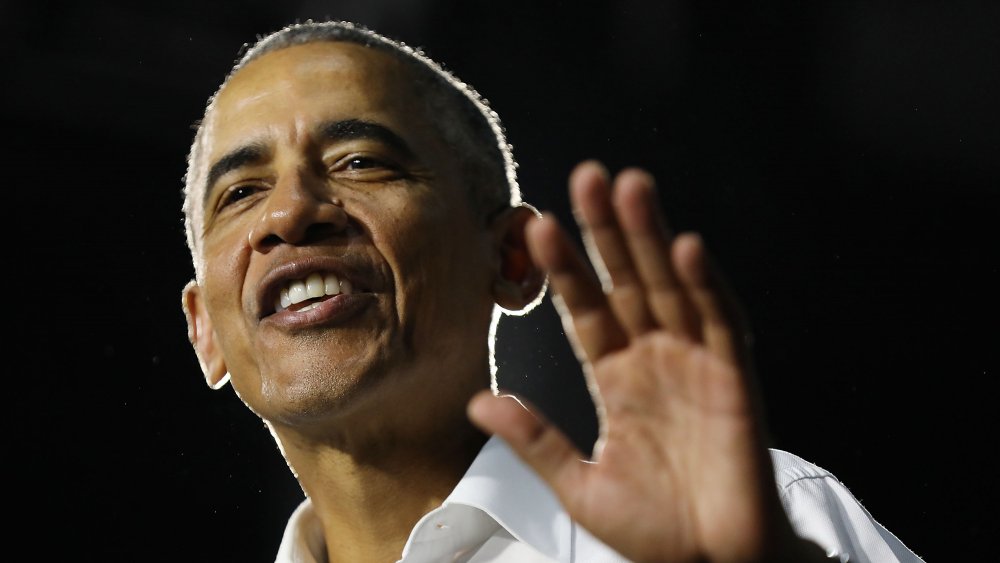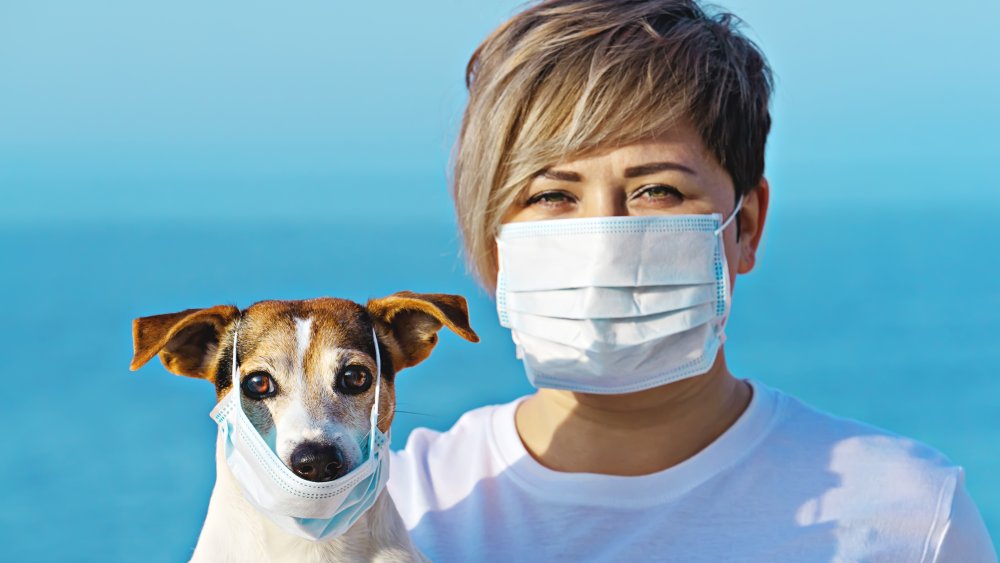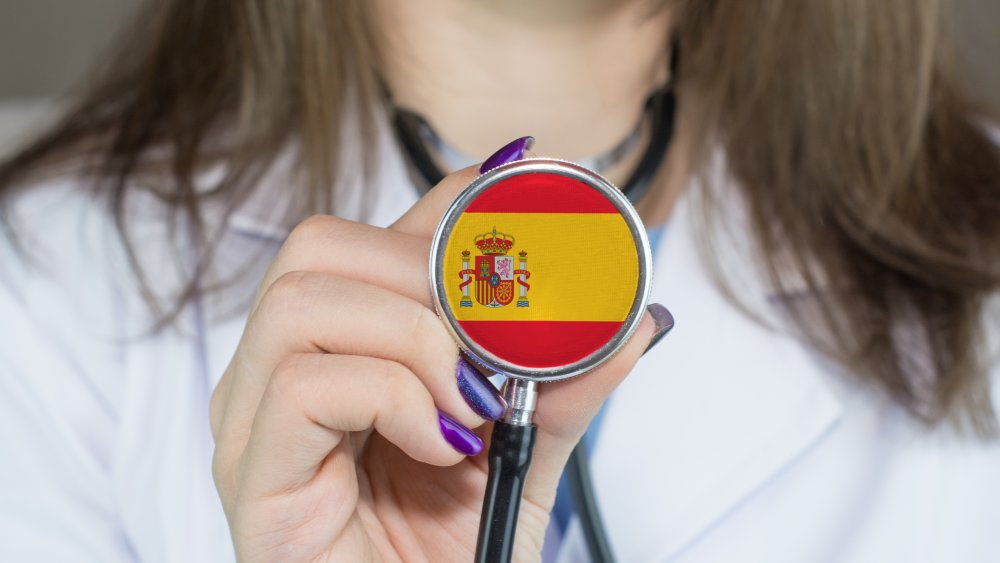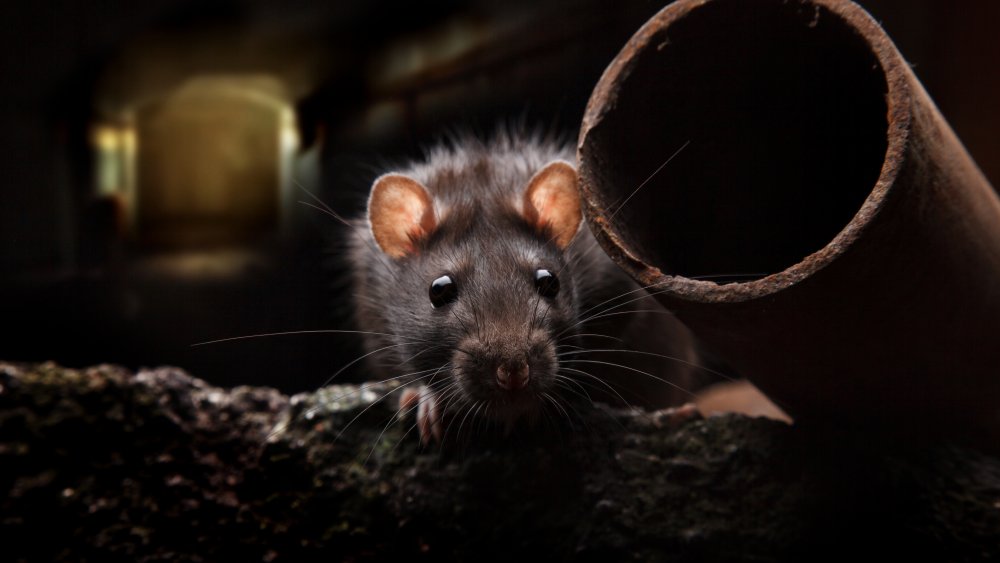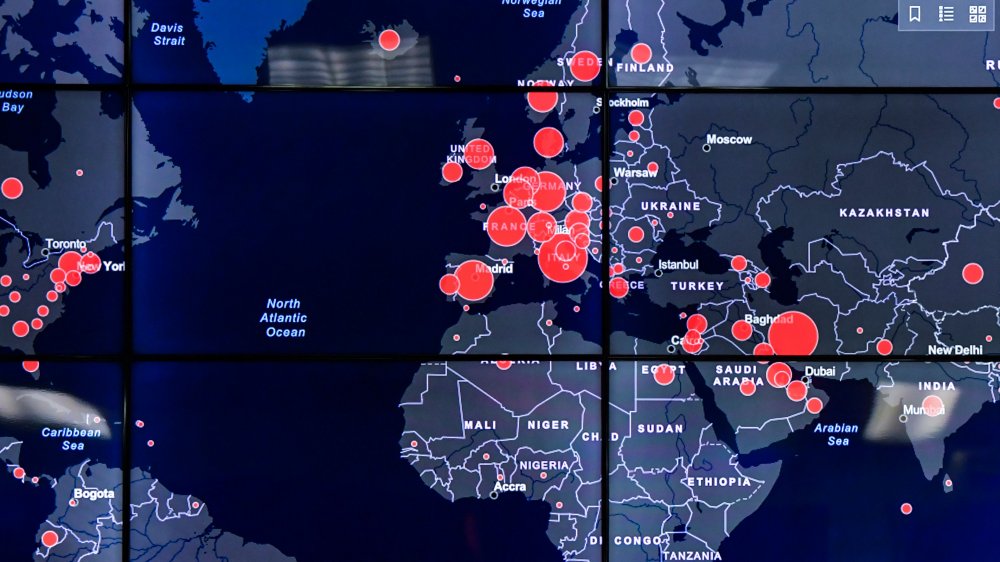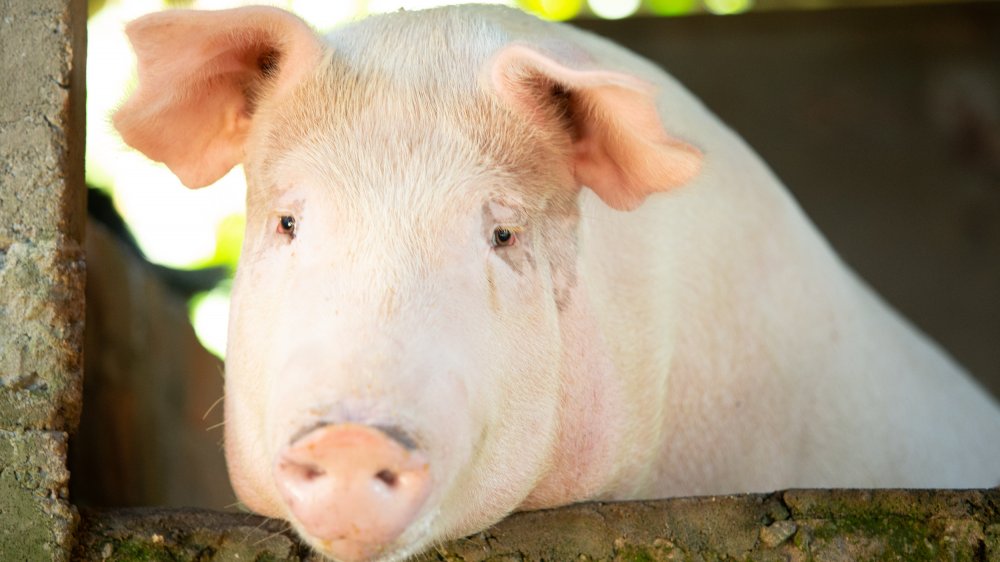False Facts About Pandemics That Everyone Thinks Are True
In late 2019, a strange new disease appeared around Wuhan, China. Within a few months, it had spread across the globe. As of this writing, there are still many unknowns. Will society continue to shut down, and if so for how long? How many people will be affected? Will the economy recover? And at what point of social distancing do you lean into it and start putting on plays you wrote starring your dog?
While there are a lot of scary unknowns, there are plenty of things we can and do know at this point. It's important to listen to legitimate medical sources about what you should and should not do during a pandemic. Wash your hands often, maintain social distance, and you'll probably be fine. Unfortunately, there are a lot of myths about coronavirus and about disease outbreaks out there, many concerning the current COVID-19 crisis, and a few oldies but baddies are still hanging around from past pandemics. Thanks to social media, it's easier than ever to spread misinformation, giving people a false sense of security or putting them in danger. Let's nip some of these false facts about pandemics in the bud right now. And when in doubt, just remember if it sounds too good to be true, then it's probably not true.
Myth: Taking ridiculous amounts of Vitamin C will boost your immune system and protect you from COVID-19
During a pandemic, when everyone is freaking out about getting whatever disease is going around, it makes sense that people will reach for some simple, cheap way to protect themselves. One that was readily available. Something that didn't involve big medical terms that are confusing and kind of scary. This magic bean does not exist.
That doesn't keep people from claiming it does, though. That's why you might have seen social media posts or articles on less reputable sites that claim filling your body to the brim with vitamin C will protect you from something like COVID-19. The idea is that by chugging gallons of OJ or swallowing dozens of vitamin C supplements, you will boost your immune system enough to be able to fight off any virus that comes near it.
According to Live Science, the idea was first put forward by Linus Pauling, a guy who won not one, but two Nobel Prizes. So he must be smart, right? Well, since he wrote books on his vitamin C theory in the 1970s, no subsequent studies have backed him up, so maybe not. Overdosing on vitamin C doesn't even stop you getting the common cold, let alone a scary new virus. It won't hurt you, but it's not a citrus fruit-based magic shield of protection.
Myth: Every election year has a disease/pandemic
Pandemics are scary, and scary things are a breeding ground for conspiracy theories. Throw in the us vs. them mentality of politics, and you have a perfect storm.
By February 2020, social media was filled with posts stating that every election year since 2004, there was a pandemic or other major disease outbreak. Some were implying that this was a way to distract or panic the populace, thus affecting the outcome of the election. Just how it would do this or who it would benefit is not explained. Readers are just supposed to accept that 1) there indeed have been pandemics every election year and 2) this is not a coincidence. Someone is making it happen for ... reasons.
There are many problems with this dopey idea. For one, while the posts claim it's "every" election since 2004, the list includes midterm elections but leaves out 2006, so whoever put it together couldn't find something to stretch to there. More importantly, as Politifact discovered, "most of these connections weren't real." For example, the SARS outbreak ended by July 2003, and appears to have come up just once in the whole 2004 election. Likewise, while swine flu was the "first global flu pandemic in 40 years," there was a vaccine for it by 2009, and Politifact "found no examples of representatives using H1N1 in their campaigns during the 2010 midterm elections." There are similar problems with the rest of the list. There just isn't a connection between outbreaks and elections.
Myth: Sipping water every 15 minutes will protect you from COVID-19
There's a ton of false information to sift through on the internet at the best of times, so when you're looking for tips on how to stay healthy during a pandemic, you're going to run into a lot of BS.
One viral (pun pretty much unavoidable) post during the beginning of the COVID-19 pandemic said, "Take a few sips of water every 15 mins at least. WHY? Even if the virus gets into your mouth ... drinking water or other liquids will WASH them down through your esophagus and into the stomach. Once there in tummy ... your stomach ACID will kill all the virus. If you don't drink enough water more regularly ... the virus can enter your windpipes and into the LUNGS."
According to Snopes, this is not true in the slightest and is absolutely not how anything works. Drinking water is a good idea, but it won't stop you from getting sick. What made the post dangerous was the claim this advice was from "doctors." There was often a second part about doing a self-check every morning to make sure you are still COVID-19-free, by holding your breath for 10 seconds, which is supposedly recommended by other vague medical experts. This is totally made up as well. The tip-off is these posts don't link to actual legitimate sources to back up what they are claiming, which means it's just from randoms on the internet, and you should never believe randoms.
Myth: The pandemic was created in a lab
When things go wrong, people instinctively look for someone to blame. It's how we make sense of the world: Bad things must happen because someone bad made them happen, and we need to identify the culprit. Politicians are easy scapegoats — after all, they're in charge. But they don't want to be the bad guy, especially during an election year. So they have to point the finger at someone else. That might be why President Trump and his supporters were very quick to pin the spread of COVID-19 on China. In a tweet on March 16, 2020, Trump xenophobically referred to the disease as the "Chinese Virus."
You could give the benefit of the doubt and assume that the president simply meant that's where the virus originated. Regardless, other people picked up the ball and ran with it. According to Vox, some claimed that COVID-19 didn't appear organically but was created by the Chinese government in "a level 4 (the highest biosafety level) research laboratory in Wuhan" and released into the population. This claim even made it onto Fox News.
It turns out we actually have a pretty good idea where COVID-19 originated. Large groups of infection disease experts have studied the virus, and say they have evidence it "is brand new and came from nature." This isn't the first time this claim has been made about a pandemic. Some people believe Ebola originated in a lab as well, but there's no evidence of that either.
Myth: The 5G network is to blame for COVID-19
Viruses aren't the only scary thing in the world. There's technology too. Take people inclined to conspiracy theories and give them the chance to combine the two and they'll be quite happy. Fortunately, China gave them that opportunity, since COVID-19 originated in Wuhan, a city that was one of the first places to trial the new 5G mobile internet network. Obviously, this couldn't be a coincidence.
We know this from no less source than God himself. Of course, we have to take the word of a conspiracy theorist named Dana Ashlie that God told her. According to The Next Web, in an hour-long video, she explains 5G "led to a sickness with the symptoms of radiation poisoning." (COVID-19 looks nothing like radiation poisoning, but let's press on.) The video was then shared by Dutch "UFO researcher" John Kuhles who said the rollout of 5G and the emergence of the virus was "certainly not" a coincidence. Eventually, the video would lead to a viral social media post that was an absolute smorgasbord of conspiracy theory terms like "mandatory vaccines," "chemtrails," "weaponized technology," and the astonishing claim that "a person's organ functions can be stopped remotely if one is deemed non-compliant."
Just ... no. The idea 5G would be dangerous comes from a flawed study done way back in 2000, which has been thoroughly debunked. And Wuhan wasn't special when it came to 5G: It was one of 16 cities testing it.
Myth: Masks will save you from disease
You would be forgiven for thinking toilet paper was a magic force field against viruses, considering how crazy people went over it during the beginning of the COVID-19 pandemic. But there was mass panic-buying and hoarding of other things too, especially items that actually seemed to have health-related uses. Hand sanitizer and soap, both genuinely helpful, flew off the shelves.
So did facemasks. Pictures emerged everywhere of regular people and even celebrities walking around with their faces covered. Some people even tried to improvise, blocking their mouths and noses with everything from plastic boxes to sanitary pads.
You might think a facemask (a real one, not one MacGyvered out of toilet paper) would help protect you from COVID-19. After all, healthcare professionals wear masks in hospitals. Even plague doctors wore them, and they didn't even wash their hands! But according to a medical journal (via the New York Times), "there is no evidence that face masks are effective in preventing healthy people from becoming ill." For one, most masks (like the ones above) are not capable of stopping viruses, and most people wear them wrong, leaving gaps. Wearing one makes you more likely to touch your face, which spreads the disease. The masks are also only meant to be worn for a few hours at a time, but most regular people won't change them that often. And the masks U.S. healthcare workers wear, which are much more advanced than regular surgical masks, need to be specially fitted once a year to be effective.
Myth: The 1918 flu pandemic originated in Spain
If Trump gets his way, the COVID-19 pandemic of 2020 might one day be known as the Chinese flu. This would, of course, be based on racism and xenophobia, and hopefully it won't stick, but at least it would accurately reflect where the virus originated. The same cannot be said for the "Spanish flu" pandemic in 1918.
You'd obviously assume that if it's called the "Spanish" flu, it must have started in Spain. In fact, this followed a long tradition of naming diseases for places that got unfortunately associated with them, not where they began. (For example, "the French disease," now known as syphilis, actually originated in the Americas.)
According to History, it was originally called that because of complications arising from World War I. During the conflict, Spain was one of the few countries in Europe that remained neutral. This meant the government wasn't censoring the press, unlike in countries involved in the fighting. When people started getting sick and dying, these nations suppressed that information from their citizens and the wider world, worrying it would damage morale. But Spain wasn't under wartime press limitations, so their sickness made headlines. Everyone was reading about how this flu was ravaging Spain, unaware it was doing the same everywhere else, too. Spain got the blame, and the name stuck. In reality, no one knows where it began, although the United States, France, China, and Britain are all possibilities.
Myth: The 1918 flu pandemic was caused by a 'super-virus'
Once the COVID-19 pandemic began, the average person became a lot more knowledgeable about a relatively recent pandemic that killed millions. Even if you didn't learn about the 1918 influenza pandemic in school, you're probably hearing about it during the coronavirus outbreak.
The 1918 flu was scary for many reasons. According to medical microbiologist John Brundage (via New Scientist), it was "the most lethal natural event that has occurred in recent human history." It came right as World War I was ending, giving the world a double whammy of death. And unlike most flu strains, this one killed more young, healthy people than it did the old and enfeebled. This, along with the massive death toll, made a lot of scientists and laypeople alike think it must have been special. No normal flu could kill so many. It must have been ... a super-virus. (Dun-dun-DUNNN.)
But the evidence no longer supports this. The problem with flu isn't actually the flu itself, it's the complications that arise from it. A common one is bacterial pneumonia. Scientists now believe that bacterial pneumonia, not the flu virus, killed most of the victims in 1918. The flu weakened their immune systems and ravaged the respiratory tract, making it easy pickings for bacteria. One key piece of evidence is that most people lingered for weeks before dying rather than passing within a few days. This points to pneumonia being the culprit and not flu.
Myth: Rats are to blame for the Black Death
Rats have long gotten the blame for the Black Death, a plague that spread through Europe and other parts of the world around 1348, killing a truly astonishing number of people: up to 125 million by some estimates, over a quarter of the people on the planet. Rats were everywhere, and they brought with them fleas, which were the vehicle through which it was believed the plague was passed along. The idea was the rats carried plague-infected fleas, got the plague themselves, died, and then the blood-sucking parasites needed new hosts, so they hopped on to passing humans, who then also got sick.
But maybe the poor rats were being slandered this whole time. According to Live Science, there's solid evidence that while the plague was spread by parasites, it was human parasites that were to blame. In other words, not fleas that normally fed on rats, but fleas and ticks that normally fed on humans. The rats might have had nothing, or at least very little, to do with it.
Researchers noticed there aren't contemporary records that mention huge numbers of rats dying off, which you'd need if the fleas were going to have a reason to jump to humans. And while in modern-day cases, plague is indeed usually spread by fleas from rats biting humans, the Black Death spread so much faster and farther and was more deadly than modern outbreaks, that it must have been spread differently.
Myth: Developed nations have nothing to fear from pandemics
No matter how egalitarian and woke they might claim to be, people in developed nations often unintentionally look down on those who are less well-off. There are biases about what used to be called the third world, even among researchers who study the areas. This is especially true when it comes to pandemics.
The World Health Organization admitted this outright when it said that as recently as the beginning of the 21st century, "most experts believed that the exotic pathogens that cause so much misery in Africa and densely-populated parts of South-East Asia would never become a problem in wealthy countries, with their high standards of living and well-developed health systems." Oh yes, look at us rich nations over here, not all dirty and disease-ridden like some places we could mention.
But disease doesn't care who you are or what your GDP is. That became alarmingly clear during the 2003 SARS outbreak. The WHO says the virus "took its heaviest toll on wealthy urban areas." And those well-developed health systems? Turns out SARS "spread most efficiently in sophisticated hospital settings." Experts had only just gotten the egg off their faces when the 2009 H1N1 influenza pandemic hit. While those in the West looked at the poor areas of Asia with its H5N1 and tutted about how they needed to contain it, a different strain in their neck of the woods was the one that ended up exploding into a major problem.
Myth: Obama only declared H1N1 an emergency after millions of people were infected
Because many people are pointing out various mistakes Trump and his administration have made in the fight against COVID-19, the president's supporters have defended him. Some of them have said that, actually, Trump is doing amazing because when Obama was in charge and faced a pandemic, he did nothing.
According to Snopes, this claim originated on the conservative site PJ Media on Feb. 28, 2020. Their article stated, "In April of 2009, the H1N1 became a pandemic. But it wasn't until six months later, October, that then-President Obama declared a public health emergency on what was already a pandemic. By that time, the disease had infected millions of Americans and more than 1,000 people had died in the U.S."
So much is incorrect there. Obama declared a national emergency in October, not a public health emergency, because he'd already done that in April, two months before swine flu was declared a pandemic. There had been 20 cases in America when Obama declared swine flu a public health emergency, which is significantly fewer than "millions." His April declaration stated that "as a nation, we have prepared at all levels of government, and as individuals and communities, taking unprecedented steps to counter the emerging pandemic." His administration also took aggressive measures at that time, like shipping "12 million doses of flu-fighting medications from a federal stockpile." Far from waiting until it was already a pandemic to act.


